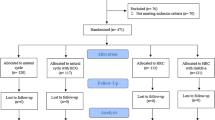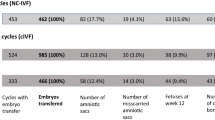Abstract
Morphologic studies of the endometrium have demonstrated that varying the duration of an artificial follicular phase (AFP) in women with ovarian failure did not adversely affect its developmental capacity. The aim of this study was to evaluate whether such manipulations of endometrial stimulation could influence the pregnancy rate in women undergoing oocyte donation (OD). Twenty-nine women were investigated in 51 cycles of OD. Endometrial preparation was performed with a fixed dose of micronized estradiol, 4 mg/day, administered for 5–35 days in accordance with oocyte availability. On the day of donation progesterone in oil, 50 mg/day, was added to the regimen. Oocytes were donated anonymously by patients undergoing routine in vitro fertilization. Fifteen clinical pregnancies were achieved, for a success rate of 29.4%. Using logistic regression analysis the success rate was found to be closely associated with the duration of estrogen stimulation. The pregnancy rate was 7.7, 52, and 7.7% after an AFP of 4–11, 12–19, and 20–29 days, respectively. It seems that for optimal results in an OD program, estrogen stimulation should be kept at between 12 and 19 days. These results also imply that, contrary to endometrial morphology, which seems to be tolerant to extreme AFP durations, functional receptivity is less permissive and is adversely affected by such manipulations.
Similar content being viewed by others
References
Lutjen P, Trounson A, Leeton J, Findlay J, Wood C, Renou P: The establishment and maintenance of pregnancy using in vitro fertilization and embryo donation in a patient with primary ovarian failure. Nature 1984;307:174–175
Navot D, Laufer N, Kopolovic J,et al. Artificially induced cycles and establishment of pregnancies in the absence of ovaries. N Engl J Med 1986;314:806–811
Devroey P, Braeckmans P, Camus M,et al. Pregnancies after replacement of fresh and frozen-thawed embryos in a donation program.In Future Aspects in Human in Vitro Fertilization, W Feichtinger, P Kemter (eds). Berlin, Springer-Verlag, 1986, p 133
Salat-Baroux J, Cornet D, Alvarez S,et al. Pregnancies after replacement of frozen-thawed embryos in a donation program. Fertil Steril 1988;49:817–821
Serhal P, Craft I: Simplified treatment for ovum donation. Lancet 1987;1:687–688
Serhal PF, Craft IL: Ovum donation in 61 patients. Lancet 1989;1:1185–1187
Cameron IT, Rogers PA, Caro C, Harman J, Healy DL, Leeton JF: Oocyte donation: A review. Br J Obstet Gynecol 1989;96:893–899
Ben-Nun I, Ghetler Y, Gruber A, Jaffe R, Fejgin M: Egg donation in an in vitro fertilization program: An alternative approach to cycle synchronization and timing of embryo transfer. Fertil Steril 1989;52:683–687
World Health Organization: A prospective multicentre trial of the ovulation method of natural family planning. III. Characteristics of the menstrual cycle and of the fertile phase. Fertil Steril 1983;40:773–778
Younis JS, Mordel N, Ligovetzky G, Lewin A, Schenker JG, Laufer N: The effect of a prolonged artificial follicular phase on endometrial development in an oocyte donation program. J Vitro Fert Embryo Transfer 1991;8:84–88
Navot D, Anderson TL, Droesch K, Scott RT, Kreiner D, Rosenwaks Z: Hormonal manipulation of endometrial maturation. J Clin Endocrinol Metab 1989;68:801–807
Amenorrhea.In Clinical Gynecologic Endocrinology and Infertility, 4th ed. L Speroff, RH Glass, NG Kase (eds). Baltimore, Williams & Wilkins, 1989, p 165
Laufer N, Grunfeld L, Garrisi J: In-vitro fertilization.In Infertility—A Comprehensive Text, MM Seibel (ed). Norwalk, Appleton & Lange, 1990, p 481
Bishop YMM, Fienberg SE, Holland PW: Discrete Multivariate Analysis: Theory and Practice. Cambridge, MA, MIT Press, 1975
Fienberg SE: The Analysis of Cross-Classified Categorical Data, 2nd ed. Cambridge, MA, MIT Press, 1980
SAS Institute: SAS/Stat Guide for Personal Computers, Version 6 Edition. Cary,, NC, SAS Institute Inc., 1987
Noyes RW, Hertig AT, Rock J: Dating the endometrial biopsy. Fertil Steril 1950;1:3–25
Manners CV: Endometrial assessment in a group of infertile women on stimulated cycles for IVF: Immunohistochemical findings. Hum Reprod 1990;5:128–132
Abdalla H, Kirkland A, Barber R,et al. Oocyte donation, factors affecting outcome in 152 cycles. II Joint Meeting of the European Society of Human Reproduction and Embryology, Milan, Italy, Aug 39–Sept 1, 1990, Abstr 92
Scott RT, Rosenwaks Z: Oocyte donation—state of the art 1989.In Advances in Assisted Reproductive Technologies, S Mashiachet al. (eds). New York, Plenum Press, 1990, p 633
Author information
Authors and Affiliations
Rights and permissions
About this article
Cite this article
Younis, J.S., Mordel, N., Lewin, A. et al. Artificial endometrial preparation for oocyte donation: The effect of estrogen stimulation on clinical outcome. J Assist Reprod Genet 9, 222–227 (1992). https://doi.org/10.1007/BF01203817
Received:
Accepted:
Issue Date:
DOI: https://doi.org/10.1007/BF01203817




